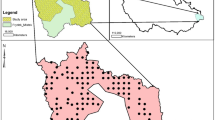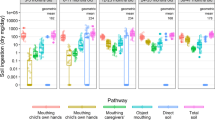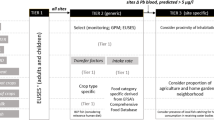Abstract
Objectives:
Using environmental concentrations and Geographic Information Systems (GIS) to model human exposure is an emerging tool in environmental epidemiology. To evaluate the usefulness of this, we investigated to what extent cadmium and lead concentrations in soil and moss could be used as potential determinants for cadmium and lead exposure for a population living near a battery plant. Methods: Cadmium in urine and blood and lead in blood, as well as food, smoking habits, places of residence, occupations and health, were determined for 512 individuals living near a closed down battery factory in Sweden. Cadmium and lead contents in moss were available through previous assessments by the Geological Survey of Sweden. Soil samples had been collected at various distances from the factory, and analyzed for cadmium and lead contents in 1990. Kriging technique in GIS was used to create areas with different metal concentrations based on these measurements. By linking individual address coordinates to mapped concentration levels, each study subject home address received a value of cadmium and lead in moss and soil. Results: We found a statistically significant association between lead in soil and lead in blood, for female subjects eating homegrown vegetables regularly. No significant association was found between cadmium in soil and cadmium in urine for either gender in the study population. No clear associations were found for either gender regarding lead and cadmium in moss and lead in blood or cadmium in urine or in blood. Conclusion: In general, environmental concentrations may not be useful surrogates for assessing human exposure to lead and cadmium, but concentrations of metals in soil around emitting point sources can be a complement for estimating the exposure in certain subgroups.
This is a preview of subscription content, access via your institution
Access options
Subscribe to this journal
Receive 6 print issues and online access
$259.00 per year
only $43.17 per issue
Buy this article
- Purchase on Springer Link
- Instant access to full article PDF
Prices may be subject to local taxes which are calculated during checkout


Similar content being viewed by others
References
Andersson A. Trace elements in agricultural soils—fluxes and balances, Swedish Environmental Protection Agency report 4077,, 1992: (in Swedish).
Bergbäck B., and Carlsson M. Heritage of cadmium and lead. A case study of a Swedish accumulator factory. Sci Total Environ 1995: 166: 35–42.
Berglund M., Åkesson A., Nermell B., and Vahter M. Intestinal absorption of dietary cadmium in women is dependent on body iron stores and fiber intake. Environ Health Perspec 1994: 102: 1058–1066.
Bernard A.M., Vyskocil A., Roels H., Kriz J., Kodl M., and Lauwerys R. Renal effects in children in the vicinity of a lead smelter. Environ Res 1995: 68: 91–95.
Björkman L., Vather M., and Pedersen N.L. Both the environment and genes are important for concentrations of cadmium and lead in blood. Environ Health Perspect 2000: 108: 719–722.
Bolviken B. Relationships between nasopharyngeal carcinoma and radioactive elements in soils in China. Med Hypotheses 2000: 55: 513–516.
Bolviken B., Flaten T.P., and Zheng C. Relations between nasopharyngeal carcinoma and magnesium and other alkaline earth elements in soils in China. Med Hypotheses 1997: 48: 21–25.
Briggs D.J., de Hoogh C., Gulliver J., Wills J., Elliot P., and Kingham S.A. A regression-based method for mapping traffic-related air pollution: application and testing in four contrasting urban environments. Sci Total Environ 2000: 253: 151–167.
Davis J.C. Statistics and Data Analysis in Geology Vol. 2. Wiley, New York, 1986.
Elinder C-G., Kjellström T., Lind B., Linnman L., Piscator M., and Sundstedt K. Cadmium exposure from smoking cigarettes: variations with time and country where purchased. Environ Res 1983: 32: 220–227.
Friberg L., Elinder C-G., Kjellström T., and Nordberg G. Cadmium and Health: a Toxicological and Epidemiological Appraisal, Vol. 2, CRC Press, Boca Raton, FL, 1986.
Grawe K.P., Thierfelder T., Jorhem L., and Oskarsson A. Cadmium levels in kidney from Swedish pigs in relation to environmental factors-temporal and spatial trends. Sci Total Environ 1997: 208: 111–122.
Haglund B., Ryckenberg K., Selinus O., and Dahlquist G. Evidence of a relationship between childhood-onset type I diabetes and low groundwater concentration of zinc. Diabetes Care 1996: 19: 873–875.
Hallberg L., Hultén L., Lindstedt G., Lundberg P.A., Mark A., Purens J., Svanberg B., and Swolin B. Prevalence of iron deficiency in Swedish adolecents. Pediatr Res 1993: 34: 680–687.
Järup L., Berglund M., Elinder C-G., Nordberg G., and Vahter M. Health effects of cadmium exposure-a review of the literature and a risk estimate. Scand J Work Environ Health 1998: 24: 1–51.
Järup L., Hellström L., Alfvén T., Carlsson M., Grubb A., Persson B., Petersson C., Spång G., Schutz A., and Elinder C-G. Low level cadmium exposure and early kidney damage—the OSCAR study. Occup Environ Med 2000: 57: 668–672.
Lin M.C., Chiu H.F., Yu H.S., Tsai S.S., Cheng B.H., Wu T.N., Sung F.C., and Yang C.Y. Increased risk of preterm delivery in areas with air pollution from a petroleum refinery plant in Tiawan. J Toxicol Environ Health 2001: 64: 637–644.
Needleman H.L., and Bellinger D.C. The health effects of low level exposure to lead. Annu Rev Public Health 1991: 12: 111–140.
Ohlsson S-Å. Mapping of heavy metals in the environment (in Swedish). Kalmari Sveriges Geologiska Undersökning, Kalmar, 1990.
Petrela J., Camara V.M., Kennedy G., Bouyahi B., and Zayed J. Health effects of residential exposure to aluminum plant air pollution. Arch Environ Health 2001: 56: 456–460.
Ruhling Å. Atmospheric heavy metal deposition in Europe—estimation based on moss analysis. Report 9, Nordic Council of Ministers, Copenhagen, 1994.
Ruhling Å. Atmospheric heavy metal deposition in the County of Kalmar (in Swedish), The Air Care Society of the County of Kalmar, 1998.
Ruhling Å., Stennes E., and Berg T. Atmospheric heavy metal deposition in northern Europe. Report 37, Nordic Council of Ministers, Copenhagen, 1996.
Ruhling Å., and Tyler G. Sorption and retention of heavy metals in the woodland moss Hylocomium splendens. Oikos 1970: 21: 92–97.
Shinn N.J., Bing-Canar J., Cailas M., Peneff N., and Binns H.J. Determination of spatial continuity of soil lead levels in an urban residential neighborhood. Environ Res 2000: Jan: 82: 46–52.
Staessen J.A., Lauwerys R.R., Ide G., Roels HA., Vyncke HA., and Amery A. Renal function and historical environmental cadmium pollution from zinc smelters. Lancet 1994: 343: 1523–1527.
Staessen J., Roels H.A., Emilianov D., Kuznetsova T., Thijs L., Vangonsveld J., and Fagard R. Environmental exposure to cadmium, forearm bone density, and risk of fractures: prospective population study. Lancet 1999: 353: 1140–1144.
Tyler G. Moss analysis—a method for surveying heavy metal deposition. In: Englund H.M. and Berry W.T., (Eds.). Proceedings of the Second International Clean Air Congress. Academic Press, New York, 1970.
Vahter M., (Ed.). Assessment of human exposure to lead and cadmium through biological monitoring. Stockholm: National Swedish Institute of Environmental medicine and Department of Environmental Hygiene, Karolinska Institute, 1982: pp. 136.
Vahter M., Berglund M., Lind B., Jorhem L., Slorach S., and Friberg L. Personal monitoring of lead and cadmium exposure—a Swedish study with special references to methodological aspects. Scand J Work Environ Health 1991: 17: 65–74.
Ward M., Nuckols J., Wiegel S., Maxwell S., Cantor K., and Miller R. Geographic information system. A new tool in environmental epidemiology. Ann Epidemiol 2000a: 10: 477.
Ward M., Nuckols J., Wiegel S., Maxwell S., Cantor K., and Miller R. Identifying populations potentially exposed to agricultural pesticides using remote sensing and Geographic Information System. Environ Health Perspect 2000b: 108: 5–12.
WHO. Cadmium. Environmental Health Criteria, Vol 134. World Health Organization, Geneva, 1992: pp. 280.
WHO. Inorganic Lead. Environmental Health Criteria 165, International Programme on Chemical Safety. World Health Organization, Geneva, 1995.
Williams F.L., and Ogston S.A. Identifying populations at risk from environmental contamination from point sources. Occup Environ Med 2002: 59: 2–8.
Wingren G., and Axelson O. Cluster of brain cancers spuriously suggesting occupational risk among glassworkers. Scand J Work Environ Health 1992: 18: 85–89.
Acknowledgements
The study was supported by grants from the Swedish Council for Planning and Coordination of Research and the Swedish Environmental Protection Agency. We thank Dea Carlsson and Bo Bergbäck, who helped us with soil and production data.
Author information
Authors and Affiliations
Corresponding author
Rights and permissions
About this article
Cite this article
Hellström, L., Järup, L., Persson, B. et al. Using environmental concentrations of cadmium and lead to assess human exposure and dose. J Expo Sci Environ Epidemiol 14, 416–423 (2004). https://doi.org/10.1038/sj.jea.7500340
Received:
Accepted:
Published:
Issue Date:
DOI: https://doi.org/10.1038/sj.jea.7500340



